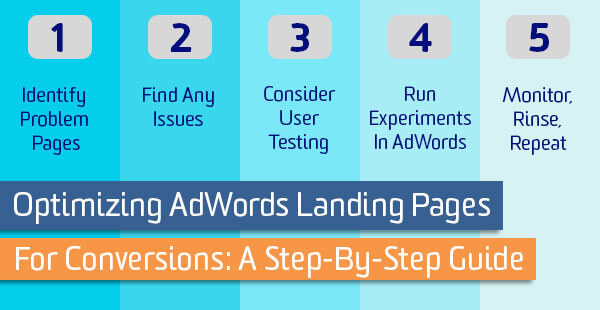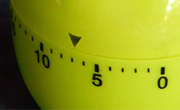Optimizing AdWords Landing Pages For Conversions: A Step‑By‑Step Guide

Landing page experience is a major factor in how well your ads perform and how often visitors complete your goals, but it is often one of the last elements in Quality Score that gets an update when people aren’t converting.
We all do it. We look at the ad copy and the keywords first because they’re the easiest to fix. You can change those all you want, but if the landing page doesn’t do it for the user, the conversions aren’t going to happen.
We’ve put it off long enough. Today, you have a step-by-step process to identify pages that need a little more oomph, tools to A/B test and experiments to run. Let’s increase those conversions! (Yes, I am actually excited.)
1. Identify Problem Pages
Google AdWords tells us to focus on the “Big Three” factors that affect ad quality which include ad relevance, expected CTR, and landing page experience. Let’s focus on the landing page portion and get to work finding your major offenders.
We can do this easily with Google Analytics. The goal here is to improve our quality score, which is Google’s ranking of the quality of your ad, landing page and keywords. Since AdWords only gives you one rolled-up metric, we’re going to unravel it by focusing on the following metrics:
- Bounce rate
- Keywords
- Conversions
Follow these steps:
- Log into your Google Analytics account and set your date range. Make sure it’s longer than 2-3 weeks.
- Click on AdWords in the left sidebar. Click on Final URLs in the dropdown menu.
- Click Secondary Dimension (right above the chart) and choose Keyword.
- Scroll to the right side of the page. Under the Conversions drop down, choose your goal(s). If you’re advertising for all of them, pick All Goals.
- Sort the Bounce Rate column from most to least so you can see all of the pages people are landing on and leave most frequently.
- Change Sort Type to Weighted to focus on higher traffic pages with high bounce rates.
- Export these pages into Excel or Google Sheets to better manage them. Note: Your header column should look the image below before you export.

Sift through your spreadsheet and notice the pages and keywords that have high bounce rates (above 70%) and little to no conversions. Ignore blog/news posts and About pages. It’s unlikely that people will convert on these. You might see some high CPCs. This can be also an indicator of pages that need attention.
2. Find Any Issues
Now that you’ve identified the problem pages, we need to determine what the specific issues are. Take a look at Google’s AdWords landing page experience guidelines to help you nail down which elements can be improved:
- Relevant, useful and original content
- Transparency and trustworthiness
- Ease of navigation
- Quick page-load times
- Mobile-friendly pages
We’ve got a collection of handy articles to help you through the process:

7-Minute User Experience (UX) Audit for Landing Pages
Take a short quiz to help determine which pages need the most help!

Quick Tips on Improving User Experience
Heather gives some great tips to keep in mind while going through this process.

6 Landing Page Optimizations You Need to Know
There are some good tidbits and template designs to help you get a better sense of how to format a landing page for conversions.
3. Consider User Testing
Sometimes the problem is very obvious, but if you’re not entirely sure you should consider A/B testing. These are tests that allow you to set up a duplicate of a landing page with just a few differing elements. For example, you might change the headline or color of your CTA button. Then, some of your users are served Page A (the original) while others are served Page B (the test page) and you’re able to determine the page elements that work best.
We all like to believe in our personal experiences and gut reactions to how a page should be designed or organized. Running an A/B Test is great for us, because it will either validate our initial impressions and tell us that the problem might be elsewhere, or it will show us that we may need to consider changes.
Free Testing Tools
There are a few great tools that can help you with conversion testing. We really like Optimizely right now, but all of the tools in that list are very helpful (and free or freemium, which is always a plus).
Paid Testing Tools
There are a number of more robust tools that can help focus on testing and that you can configure to target landing pages when a person arrives from Google AdWords or a specific campaign. I already mentioned Optimizely, and we’re loving Google Optimize right now (and are certified resellers!)
If you’re concerned about your boss’ lack of interest in A/B testing, this blog post on how to sell CRO to your boss might come in handy.
4. Run Experiments Through AdWords
Another way to test your landing pages is to run conversion experiments in AdWords. It’s really easy.
- Pick a problem landing page from your list.
- Use one of the free CRO tools to set up an alternate landing page that has different content/experience.
- Go to the ad group in your AdWords campaign that contains ads for these pages. Duplicate one of them and change the URL to the page you’d like to test against.
You should have 2 ads that look exactly the same. They will have different final URLs though. One will be your original page and the other will be the test page.
Let these run for at least 2 weeks. Preferably 1 month.
5. Monitor, Rinse, Repeat
You’re never done optimizing and that’s a good thing. You should always be looking for ways to improve. Keep pushing forward and finding what works best for you.
Happy optimizing!


